Sibelius details
Starting with the Chopin Prelude in E minor (Op. 28, No. 4) which you entered from the last Sibelius class (Sibelius 5 file and PDF file), add all of the notational details to finish the typesetting to match this original scan.
Staff spacing
The default spacing between the staves is a bit tight for this piece since there are high notes in the bottom staff, and lots of long slurs mixed with hairpin dynamic markings. To give more space for items displayed between the staves:
- Triple-click on the top staff to select it from start to end.
- Shift-drag the top staff upwards to increase the space between staves.
To adjust the staff spacing for a single system, click on one of the measures in the top staff of the system, then shif-drag the staff up or down to change the spacing between the staves on that particular system.
System spacing
To adjust the distances between systems (pairs of staves in this case), click on the top staff of a system and click-drag it up or down (similar to staff spacing but do not hold down the Shft key).
Layout
If you want to fix the number of measure on a staff, select a barline where you want a system break, and then go to the menu item Layout→Break→System Break.
If you want to generally shrink or expand the spacing of the music, select the music to adjust, and then press Alt+Shft+←/→ (or Option+Shft+←/→ on a Mac) in order to shrink/stretch the music.
Grace notes
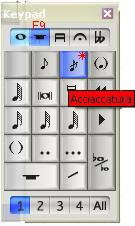
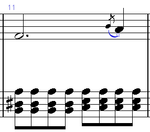
Measures 11 and 19 contain grace notes which are difficult to enter in real-time MIDI entry. To add these grace notes afterward to the score, press the F9 function key to set the numeric keypad to the extended rhythm options. Then press keypad * or click on the slashed grace note icon in the keypad window (if it is being displayed). Then click on the B pitch in measure 11 where the grace note should be added.
It would be convenient to type the letter s after inserting the grace note (while the grace note is highlighted in blue). Otherwise, you will have to add the slur in a later step...
Cross-staff notes
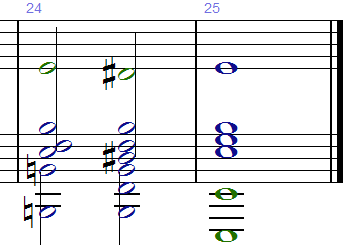
Moving notes down a staff can be done with Ctrl+Shft+↑/↓ (Command+Shft+↑/↓ on a Mac) when the notes are selected. The notes "belong" to one staff, but are displayed on another staff. In this particular case, in measure 25, there is are two chords which contain notes on two staves. This cannot be done in Sibelius on a note-by-note basis (only by complete chords), so the correct display has to be hacked:
- Insert the notes for the bottom staff in layer one of the top staff.
- Select those notes and type Ctrl+Shft+↓ to move them to the bottom staff.
- Click on the top staff to select it.
- Press n to enter note entry mode.
- Press on the "2" in the keypad window to enter notes in layer 2 on the top staff.
- Select a half-note rhythm, and insert the notes E and D♯ on the top staff.
- Click on the stem of one of the chords in the bottom staff. A small box will appear at the end of the stem. Click-drag this box so that the bottom chord stem overlaps with the note in the top staff.
Slurs
The easiest way to create a slur is to click on the first note which the slur starts, and then Shift-click on the last note within the slur. The press s to add the slur. Slurs can go across system breaks, although they will become a bit difficult to manage. For long slurs, you can also make separate slurs for each system, but only do this if you have decided on a fixed layout: if the systems break at different measures, those individual slurs will have to be corrected.
The height (curvature) of the slur can be adjusted by first highlighting the slur by clicking on it. Then you can click-drag to move the slur middle up and down. Click-dragging near the endpoint of a slur with allow adjustment of the start/end of the slur. The slurs height can be adjusted with the ↑/↓ keys as well.
Typing x while editing a slur will flip the orientation of the slur.
Articulations
fermata
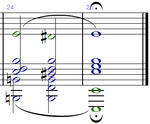
Fermatas can be added to the score by pressing F11, and then selecting the note(s)/rest(s) on which to add the fermata, and then pressing keypad 1 or clicking on the fermata icon in the keypad window.
Fermatas on notes in layer 2 will be placed upside down underneath the staff automatically.
turn

After clicking on the first note of the turn in measure 16, press z to open the symbol window. Go to the articulations and select the turn symbol.
Add the double sharp underneath the turn in a similar manner. However, select "Grace note size" in the symbol menu before inserting the double-sharp so that it appears smaller than a regular note accidental.
(Creating a composite symbol might be useful for this particular ornament).
accent

For the accent in measure 8, Sibelius will not allow the accent to be placed all of the way above the staff as a normal articulation. Instead, click on the note to select it. Then go to the menu item Create→Symbol... (or type z to open up the symbol window). Then scroll to articulations and select the accent symbol. This will place the accent as a symbol attached to the correct note, and which can be moved vertically to the desired position.
Dynamics Hairpins
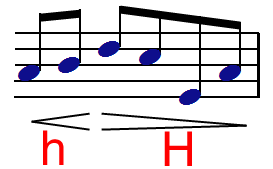
Hairpins for crescendos and decrescendos are entered in a similar manner to slurs: click on the first note that the hairpin starts, then shift-click on the last note of the hairpin. Press h to add a crescendo, or Shft+H to insert a decrescendo.
Double click on a hairpin to adjust its length. Click-drag on a hairpin to move it up and down after it has been selected.
Dynamics
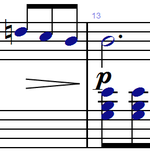
Dynamics are inserted into the music by selecting a note and then pressing e (or Command+e on a Mac). Then type the letters which make up the dynamic and then press esc when you are finished.
When entering the letters of the dynamic, use the Ctrl key (or Command on a Mac) to use the traditional font for dynamics (using the Opus font in Sibelius).
Pedal Markings
Pedal marking pars (Ped./*) are entered in a similar manner to slurs and dynamics hairpins. Select the first note of the pedal marking, then shift-click on the last note of the pedal marking. Then press the L key to insert a line in the music, and choose the Ped./* style line. Press esc to finish inserting the pedal marking.
To move the Ped./* line up or down, click on the Ped. symbol and move up or down with the arrow keys (or click-drag with the mouse).
Text
Create the Largo movement designation by clicking on the first note of the top staff and pressing Ctrl+Alt+t (Command+Option+t on a Mac), then type Largo and then esc.
Alternatively, go to the menu item Create→Text→Tempo and then type Largo and then esc.
The other italic texts (espressivo, smorz., dim., stretto can be entered as expressions with Ctrl+e (Command+e on a Mac).
Triplet markings
By default sibelius adds brackets to the tuplet markings. To remove them, the easiest method is to first hide the tuplet marking, then go to the menu item Create→Text→Special Text→Tuplet and type 3 then esc.
Finished product
Here is an example of what the music should look like after you have added all of the extra musical notation elements to the prelude: prelude.pdf.